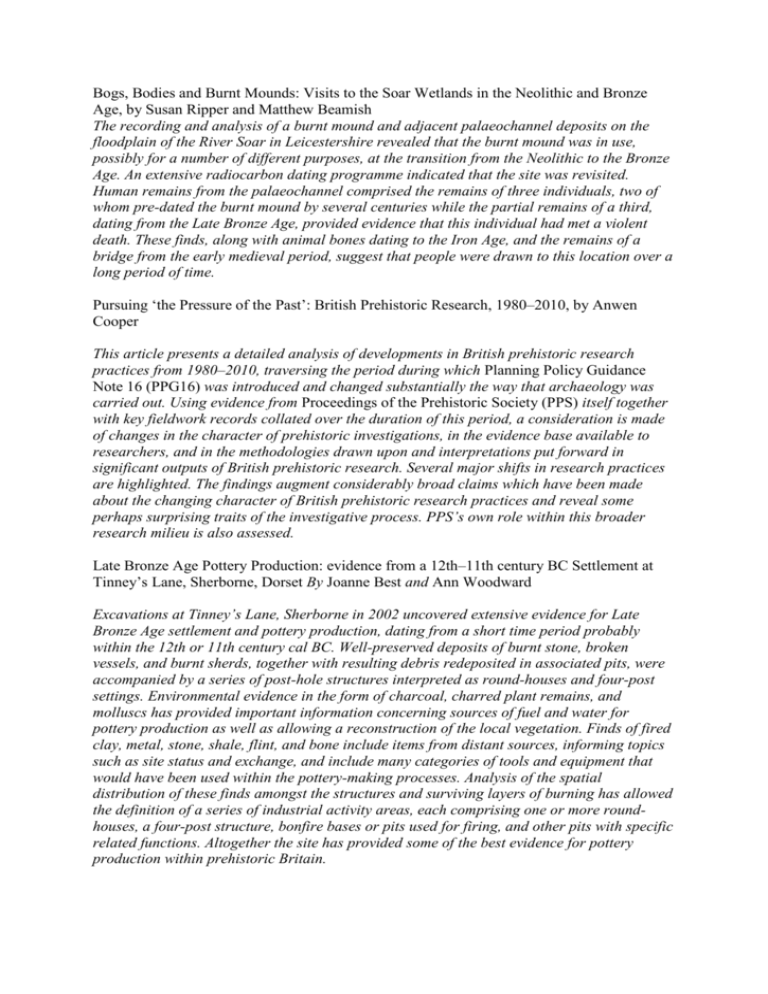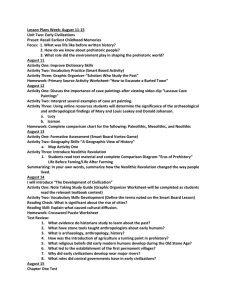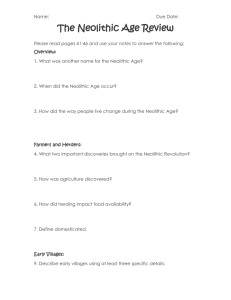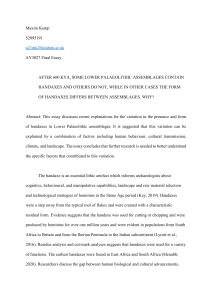Abstracts - The Prehistoric Society
advertisement

Bogs, Bodies and Burnt Mounds: Visits to the Soar Wetlands in the Neolithic and Bronze Age, by Susan Ripper and Matthew Beamish The recording and analysis of a burnt mound and adjacent palaeochannel deposits on the floodplain of the River Soar in Leicestershire revealed that the burnt mound was in use, possibly for a number of different purposes, at the transition from the Neolithic to the Bronze Age. An extensive radiocarbon dating programme indicated that the site was revisited. Human remains from the palaeochannel comprised the remains of three individuals, two of whom pre-dated the burnt mound by several centuries while the partial remains of a third, dating from the Late Bronze Age, provided evidence that this individual had met a violent death. These finds, along with animal bones dating to the Iron Age, and the remains of a bridge from the early medieval period, suggest that people were drawn to this location over a long period of time. Pursuing ‘the Pressure of the Past’: British Prehistoric Research, 1980–2010, by Anwen Cooper This article presents a detailed analysis of developments in British prehistoric research practices from 1980–2010, traversing the period during which Planning Policy Guidance Note 16 (PPG16) was introduced and changed substantially the way that archaeology was carried out. Using evidence from Proceedings of the Prehistoric Society (PPS) itself together with key fieldwork records collated over the duration of this period, a consideration is made of changes in the character of prehistoric investigations, in the evidence base available to researchers, and in the methodologies drawn upon and interpretations put forward in significant outputs of British prehistoric research. Several major shifts in research practices are highlighted. The findings augment considerably broad claims which have been made about the changing character of British prehistoric research practices and reveal some perhaps surprising traits of the investigative process. PPS’s own role within this broader research milieu is also assessed. Late Bronze Age Pottery Production: evidence from a 12th–11th century BC Settlement at Tinney’s Lane, Sherborne, Dorset By Joanne Best and Ann Woodward Excavations at Tinney’s Lane, Sherborne in 2002 uncovered extensive evidence for Late Bronze Age settlement and pottery production, dating from a short time period probably within the 12th or 11th century cal BC. Well-preserved deposits of burnt stone, broken vessels, and burnt sherds, together with resulting debris redeposited in associated pits, were accompanied by a series of post-hole structures interpreted as round-houses and four-post settings. Environmental evidence in the form of charcoal, charred plant remains, and molluscs has provided important information concerning sources of fuel and water for pottery production as well as allowing a reconstruction of the local vegetation. Finds of fired clay, metal, stone, shale, flint, and bone include items from distant sources, informing topics such as site status and exchange, and include many categories of tools and equipment that would have been used within the pottery-making processes. Analysis of the spatial distribution of these finds amongst the structures and surviving layers of burning has allowed the definition of a series of industrial activity areas, each comprising one or more roundhouses, a four-post structure, bonfire bases or pits used for firing, and other pits with specific related functions. Altogether the site has provided some of the best evidence for pottery production within prehistoric Britain. Pits and Place-making: Neolithic Habitation and Deposition Practices in East Yorkshire c. 4000–2500 BC, by Genevieve Carver This article presents the findings of a study which sought to explore the nature of Neolithic habitation practices in east Yorkshire, primarily using evidence from pits. The morphology of pits and material deposited into them were examined in order to discern the kinds of activities taking place close by, and the possible motivation behind pits being dug. The temporality, spatial organisation, and landscape distribution of pits was considered in conjunction with information from domestic features, artefact spreads, and monumental and funerary features in order to create a coherent image of the ways in which people lived in and exploited the landscape. It is argued that, given the scarcity of direct evidence for residential contexts, the information from pits can tell us about occupation practices. Viewed in conjunction with evidence for changing subsistence practices and an increasingly monumentalised landscape from the Early Neolithic onwards, the deposition of domestic material in pits is interpreted as part of cycles of renewal that created more permanent connections between people and their homes. The Maisierian, at the Edge of the Gravettian, by Damien Pesesse and Damien Flas The development of the Gravettian complex is still largely unknown. In this context, the lithic assemblage from Maisières-Canal, 14C dated around 28,000 BP, is particularly interesting. We propose here a new study of this collection, based on technological, typological and functional approaches, particularly focused on the tanged pieces and ‘Maisières points’, some of which are likely projectile points. This new study leads us to discussion of the position of this assemblage in the context of the western European Early Gravettian. The Maisierian appears to be a specific industry, different from the typical Early Gravettian, and studying it thus permits new light to be shed on the complexity of the first phases of the Gravettian, a complex that is perhaps less consistent than it would seem. An Early Upper Palaeolithic Open-air Station and Mid-Devensian Hyaena Den at Grange Farm, Glaston, Rutland, UK, by L.P. Cooper, J.S. Thomas, M.G. Beamish, A. Gouldwell, S.N. Collcutt, J. Williams, R.M. Jacobi4,5†, A. Currant4, and T.F.G.Higham6 Archaeological work preceding a housing development revealed mid-Devensian (MIS 3) deposits preserved in a geological fault, a graben feature, on an interfluve plateau. Rare evidence for Early Upper Palaeolithic open-air occupation was characterised by a scant lithic signature of the Lincombian-Ranisian-Jerzmanowician (LRJ) leaf-point technocomplex of the North European plain. The lithics included a complete leaf-point, another broken example with traces of impact damage, and knapping debitage indicating leaf-point maintenance. The site also preserved good evidence for an open-air hyaena den with abundant faunal remains. Discrete bone clusters were present, some of which probably represent meat caches for hyaena cubs in the burrows and scrapes of a maternity den. It is suggested that the hominins targeted the den site to forage the stored food. Their occupation is associated with a group of spirally-fractured wild horse bones thought to be the result of marrow extraction by humans, and these have been dated to 44,290–42,440 calibrated years before present (44.3–42.5 kyr cal BP), comparable to the date range of continental LRJ sites. The early date of the LRJ techno-complex corresponds with that of the oldest Neanderthals in northern Europe, but possibly overlaps with the recently reported early dates for anatomically modern humans. However, it is concluded that the oldest Early Upper Palaeolithic technology in northern Europe was the product of final Neanderthals. Excavations in the Acheulean Levels at the Earlier Stone Age Site of Canteen Koppie, Northern Province, South Africa, by John McNabb and Peter Beaumont The fluvial gravels of the river Vaal in South Africa have long been known as a source for Earlier Stone Age (ESA) artefacts. Most were discovered through the open cast mining for diamonds that has left very little in situ fluvial sediment remaining today. The site of Canteen Koppie is an internationally famous location with a reputation for prolific Acheulean artefacts, especially handaxes and the enigmatic prepared core and Levallois-like technology known as Victoria West. Our understanding of this site, and most other Vaal locations, is almost solely based on highly selected artefact collections. Here, we report on the first controlled excavations ever to be conducted at Canteen Koppie. The deposits are likely to date to the Early and Middle Pleistocene, and our excavations sample the full depth of the stratigraphic sequence. The lower units, first identified in these excavations, add a considerable time depth to the Acheulean occupation of the site, making this the longest chrono-stratigraphic sequence in South Africa to our knowledge. Given the current international interest in the origins of Levallois/prepared core technology (PCT), its occurrence in Unit 2b Upper, and its presence alongside Victoria West technology in Unit 2a has significant implications for debates on the role of Victoria West in the origins of PCT. From the Canteen Koppie evidence, Levallois and Victoria West are clearly rooted in the Acheulean. Recent Work at the Lower Palaeolithic Ste of Corfe Mullen, Dorset, England, by John McNabb1, Robert Hosfield2, Kevin Dearling, Dominic Barker1, Kristian Strutt, James Cole, Martin Bates3 and Phillip Toms Changes in the geological interpretation of the history of the ancient Solent river basin have focused attention on the handaxes discovered in the Corfe Mullen area during quarrying before the Second World War. Recent geological research suggests that the fluvial terrace the handaxes are associated with may pre-date the Anglian glaciation. This is important because it contributes to the question of just when the Solent basin was first occupied by hominins, and how this relates to other areas of possible contemporary pre-Anglian occupation such as the Boxgrove Marine embayment. However, the artefacts were believed to come from the bluff of the river terrace and were thus not in situ. This paper explores that question and re-examines the context from which the handaxes at Corfe Mullen were discovered. Iron Age Enclosed Settlements in West Wales, by K. Murphy and H. Mytum This paper presents the results of several years’ research on late Iron Age enclosed settlements in west Wales. Geophysical survey was conducted on 21 sites and three of these, Troedyrhiw, Ffynnonwen, and Berry Hill, were part-excavated. Most sites examined were heavily plough-damaged, but results of the surveys and excavations demonstrated that substantial archaeological remains survive. Approximately 60 enclosed settlements lay in the core study area of southern Ceredigion (Cardiganshire), half of which were oval in shape and half rectangular. Both types contain suites of buildings seen in much of the British Iron Age – round-houses and 4-/6-post structures. Evidence from the excavations supports data from elsewhere in the region indicating that small oval enclosures appear in the landscape in the 2nd–1st centuries BC, with rectangular enclosures constructed right at the end of the Iron Age. Dating is based almost entirely on radiocarbon determinations as, in common with other similar-aged sites in west Wales, artefacts are almost completely absent. It was not possible during excavation at Troedyrhiw to conclusively demonstrate late prehistoric use of the rectangular enclosed settlement, but a Roman pottery assemblage in the upper fills of the enclosure ditch coupled with a two phase entrance is interpreted as indicating Late Iron Age construction. More complex remains were revealed during excavations at Ffynnonwen, a circular enclosed settlement within a larger oval enclosure. Here, three round-houses, a 4and 6-post structure and other remains were investigated and radiocarbon dated to the 8th– 6th centuries [SC]BC[D] through to the early Romano-British period. Berry Hill, an inland promontory fort, appeared to be unfinished and abandoned. Radiocarbon determinations indicated a Late Bronze Age construction (10th–8th centuries [SC]BC[D]). The paper concludes with a consideration of a number of interpretive issues regarding settlement, enclosure, identity, and ways of living. Excavations at a Multi-period Site at Greenbogs, Aberdeenshire, Scotland and the Four-post Timber Architecture Tradition of Late Neolithic of Britain and Ireland, by Gordon Noble1, Moira Greig2, and Kirsty Millican3 This report outlines the unexpected discovery of a group of Late Neolithic structures at Greenbogs, Monymusk in Aberdeenshire, along with a series of later prehistoric features in the mid-1990s. Recent radiocarbon dating shows that two four-post timber structures found here date to the period 2890–2490 cal BC. These were found in association with a range of other features including an oval structure and diffuse areas of burning. The closest parallels for the four-post structures can be found in a slowly growing body of Late Neolithic timber structures, some being interpreted as roofed dwellings and others as roofed or unroofed monuments. This article places the Greenbogs structures in their wider context, identifies a number of unexcavated parallels in the aerial record and addresses the nature of the four-post structures found across Late Neolithic Britain and Ireland and suggests that four-post structures were a more common element of Late Neolithic architecture than previously identified. A common building type appears to have been shared across large areas of Britain and Ireland in a variety of contexts, from the seemingly mundane to the more ‘charged’, as part of elaborate monument complexes. The later prehistoric features identified at Greenbogs include a concentration of Middle Bronze Age features including graves containing cremated human bones, one with an upright urn, and a number of Iron Age pits and other features. The Greater Stonehenge Cursus – the Long View, by Roy Loveday The WSW–ENE alignment of the Greater Stonehenge Cursus appears to have been prefigured by the line of Mesolithic post-holes found in the Stonehenge car park. If this is not a coincidence, a means of transmission must be hypothesised since the post could not have survived the 4000 years separation. The fact that a significant number of henges in western lowland Britain adopt the same broad alignment hints at a very long-lived mental template. That, it is argued, is likely to have been celestially triggered and tied to seasonal rhythms. Simple luni-solar calculation (akin to that determining events as disparate as the ancient Olympic festival and present day Easter) rather than precisely measureable astronomical events, would create such azimuth clustering. The focus on April sunrises or October sunsets argues for an association with the pastoral cycle.








